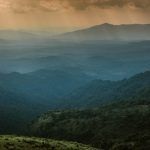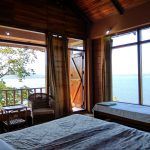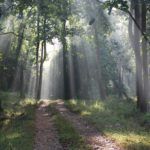Prime among the upscale properties is The Serai Resorts, a unit of Coffee Day Global Limited—the behemoth that first popularised the coffee bar culture in India with their brand of hip cafes, Café Coffee Day. While the parent company owns a whopping 12,000 acres of coffee estates in Chikmagalur, The Serai itself is sprawled across 70 acres, with almost 64 acres left to the in-house plantation and only six acres devoted to the built-up area.
The scale of the property becomes evident as you enter the gates of The Serai and drive up to a magnificent reception area built in true bungalow-style architecture—open on all sides with stout pillars supporting a grand, sloping wooden roof. The welcome drink is surprisingly hot and utterly delicious— Bellada coffee, made with coffee brewed with jaggery and served in filter coffee brass dabarah and tumbler.
You may take a battery-operated buggy to your villa, but if you choose to walk, be prepared to be greeted by thoughtful local touches in the resort’s decor—freshly-picked flowers floating in giant urli pots filled with water, a room divider made of dozens of coffee mugs arranged in rows, lighting fixtures of dried palm husks readily available in the region, and so on.

INDULGE
Experience a coffee-inspired wellness regime of a relaxing massage and soothing facial at The Serai’s in-house Oma Spa. The spa uses natural and fresh ingredients such as papaya, oatmeal, honey etc in its scrubs and freshly grounded coffee oil for its treatments that leave a lingering aroma on you, much after you’ve left feeling happy and rejuvenated.
The walk also takes you right by the emerald blue infinity pool that overlooks the resort and the plantations below, with the town of Chikmagalur nestled in the foothills of the Western Ghats in the far background.
Each villa, even the basic category of them, comes with its own private plunge pool set in a cosy garden, with a sit-out where you can spend lazy hours lounging. A gigantic wooden door slides back to reveal your bedroom—a high-ceilinged beauty with wooden floors and large glass windows overlooking the pool or the garden or the plantation beyond. The large, fluffy bed occupies centre-stage, with settees and couches placed by the windows. Another set of majestic doors lead to the bathroom—spacious and plush, with separate enclosures for the WC and the shower, double sinks, a large bathtub, plus an outdoor shower. Plants, trees and natural grass are in abundance around the property, adding to and blending right into the richness of the plantations around.
Malnad Days
Malnad or Malenadu, meaning “land of the hills”, is a richly forested, heavy rainfall area of Karnataka, covering the eastern and western slopes of the Western Ghats. Chikmagalur, along with other highly picturesque locations such as Shimoga, fall within the Malnad region. Geographically and culturally different, Malnad has a cuisine that is distinct too from the Udupi and Mangalorean fare of Karnataka most of us are familiar with. At The Serai, head chef Ramakrishna along with local chef Malesh, conducts a Malnad cuisine masterclass every evening before sunset, in an al fresco setup under swaying palm trees. This evening, he makes for us a koli saaru (chicken curry), a bendekai gojju (okra stir fry) and mutton chops, with neer dosas (water dosas) to lap them all up. We find the accent of spices, the interplay of coconut—grated or in milk form, and the overall taste of each dish so exquisite, that the staff decides to lay down a full Malnad dinner spread for us later that night.
Though barely written of, the beauty of Malnad warrants that serious travellers make a journey here at least once. We are up and on our way before sunrise the next morning to witness one such breathtaking sight it offers. In the dark of the wee hour, mysterious mists swirl in and disappear in front of the headlights of our car. The narrow road climbs up and up, before opening to panoramic views of sleepy Chikmagalur below. A few more twists and bends later, waves upon green and brown waves of the hills of the Western Ghats appear, stretching as far as the eyes can see.

We arrive at our destination, just as the horizon begins to change its colours. Climbing out of our car, we scramble for the perfect spot to fix our camera tripods, only to be told that we haven’t yet arrived at all. Apparently, this is the spot where we park our vehicles and begin the steep ascent on foot, up 480 steps to the top of the peak that stands towering in front of us—the Mullayyanagiri Hill.
Standing at a height of 6,330 feet, Mullayyanagiri is the highest peak in Karnataka and makes for one of the best treks in southern India. But what looks like a steep incline from below is in fact a gradual, comfortable trot up the side of the hill. We reach the summit just in time to witness a spectacular sunrise that bathes the neighbouring hills and ranges in a misty glow of gold. A small temple stands at the summit, dedicated to a sage who meditated in the caves a couple of feet below, which we next explore with much excitement with our guide Mohan, aka Coffee Swami for his extensive knowledge of coffee.
Later, we sit down to a picnic breakfast of sandwiches; the setting is a little meadow, the ambience is the gorgeous Western Ghats, and for music we’ve the wind playing it sweet in our ears. The day is crisp, the sky a terrific shade of clear blue streaked with white clouds. As we drive up some more hills to our next stop, the raw red colour of the earth here paints a striking picture against the blue sky. Nothing much grows in these red soils. The hill slopes high up here are covered by short tufts of grass, with a few resilient trees scattered around, all blanketed in a layer of red dust. Once though, these were fertile grounds—the very same where Baba Budan had planted the first coffee seeds. Today, an entire range of these hills is named Baba Budan Range in his honour.
One hill among them is of particular significance—Baba Budangiri. It houses a shrine to the Sufi saint, in a very interesting low-key structure. Every year during December, thousands of people of all religions flock to the shrine to celebrate the saint’s birthday. Some, however, believe that the shrine originally belonged to a Hindu saint called Guru Dathathreya.
Today though, there’s hardly a crowd in sight and our motley group ducks cautiously inside the bunker-like structure to what turns out to be a cave! Stout rock-carved pillars support the large, overhanging rocks that serve as the ceiling. You have to mind your head as you walk into the narrow tunnel towards its end, where an unpretentious shrine stands dedicated to Baba Budan or Guru Dathathreya—whichever you want to believe. His padukas (original, apparently) are carefully kept in a glass showcase. There are no tombs here though, as no one really knows where he went and died in his latter life. There are however, three small tombs close to the Baba’s shrine belonging to other saints who meditated in these hills.
Conversations Over Coffee
What makes for the best cup of coffee? Filter or instant, Arabica variety or Robusta, 100 percent pure or with added chicory, single origins or blended, to add milk or not? The points of deliberation are many. But before we can dive into this debate, it’s important, we’re told, to understand how coffee is grown and the process it goes through from the bean to the cup.
So, we venture into The Serai’s beautiful plantation, where the in-house experts walk us through the details. India contributes only about 4.5 percent of the global coffee production, yet Indian coffee is regarded as the finest shadegrown coffee in the world. Karnataka alone accounts for over 70 percent of the coffee produced, with Chikmagalur occupying first position. Chikmagalur is also the only place in India to grow more Arabica than Robusta—almost 90 percent of the coffee grown here is of the higher quality, tastier, smoother and more expensive Arabica variety. This is despite the fact that Robusta plants are hardier, more disease-resistant and easier to grow. This is possibly because the people of Chikmagalur take great pride in their coffee and nothing matters to them more than doing it right.
Harvest season is almost over when we visit; the berry pickers have all been dispersed, barring a few who go handpicking at the last remaining bushes at the speed of lightning. The ripe coffee berries once picked are spread out in the sun to dry; they’re also hand-sorted for immature or overripe fruits before being sent to the processing plant. Which is where we head to next. Disposable masks and caps are handed to us and we’re strictly forbidden to take any photographs once inside— to protect all trade secrets, they sincerely inform. Inside, we’re taken through the various steps of coffee processing— separation of the skin of the berries to expose the beans underneath, drying to achieve optimum moisture content, and milling and sorting to remove foreign particles. The beans are then graded according to their size and finally sent for roasting, grinding and packaging.
Our interest in this magic beverage has been piqued. So, we head to the R&D facility behind the processing plant to meet with its vice president, Dr Pradeep Kenjige—a highly respected name in the coffee circles. Forever smiling, Dr Kenjige shows us through a fascinating little museum housed in the facility. On display are coffee vending machines, mugs and many other paraphernalia from the very first days of Café Coffee Day until now. He also lets us hold and marvel at the prized display—Civet coffee. The most expensive coffee in the world, Civet coffee is sold at upwards of $400 a cup, and is made when the Civet cat eats the coffee berries, partially digests them and subsequently ejects them as poop!
If you wish to delve into more fascinating aspects of coffee, a quick trip to the Coffee Museum, an initiative of the Coffee Board of India, should be on the cards. All the exploring and soaking in of knowledge over the last three days leaves us feeling very coffee-educated. So, we decide to end our trip with that much anticipated debate. The stage is set—comfy, low couches around a central table laden with some delicious coffee cocktails at The Serai’s elegant bar. The setting is perfect—the moon is still shiny from the afterglow of the rare super blue blood moon eclipse that we witnessed the night before. Its radiance reflects off the water of the pool below us, and bathes the resort and the plantation in a soft glow. We sit around, business-like at first, for the matter of coffee is very important. Soon though, Dr Kenjige has us all rapt with attention as he narrates stories and anecdotes of growing up a planter’s son, his many experiments with coffee and how it became the life and soul of Chikmagalur. We move from drinks and dinner to desserts, the debate is set aside for a different day. For now, another round of steaming hot coffee awaits.
– Words SATARUPA PAUL
NAVIGATOR
GETTING THERE
By Air Mangalore (170 km) and Bengaluru (260 km) are the nearest airports.
By Train Chikmagalur Railway Station is served by a daily passenger train service from Shimoga. Nearest major railhead is Mangalore.
By Road Buses from Bengaluru run every 30-60 minutes. If you are up for a long drive, this makes for a very scenic one on the beautiful NH48 with groves of swaying palms fringing it.
STAY

The Serai Chikmagalur is a luxury resort located just outside the town centre. It has 29 villas across four categories. The two base Estate Villa categories come with either a Jacuzzi or a plunge pool, then there’s the two-tiered Estate Terrace and the exclusive Residence that comes with designer bedrooms, separate living and dining spaces and a private pool. A majestic reception building houses the multi-cuisine restaurant Odyssey, the Blue Sky Lounge, the Oma Spa, a fitness centre and a recreation centre.
Address
The Serai Resorts, Mugthihalli Post, KM Road, Chikmagalur, Karnataka – 577133
Reservation [email protected] (Exclusive booking partners)
Tariff `23,000 – `69,500 per night (American Plan All Inclusive)
DO
• Experience the journey of coffee from the bean to the cup, with coffee plantation walks and visits to processing and roasting units.
• Attend a coffee appreciation session, which showcases the proper way to make filter coffee, and exhibits the subtleties in flavour profiles of different blends.
• Attend a masterclass in the local Malnad cuisine and sample its many delicacies.
• Hike up to Mullayanagiri Hill—the highest peak in Karnataka, and witness a spectacular sunrise on the Western Ghats.
• Visit the shrine dedicated to Baba
Budan at Baba Budan Giri. The Sufi saint is credited as the first person to bring coffee to India.
• Go for a jeep safari to Muthodi Forest Reserve. Part of the Bhadra Tiger Reserve, Muthodi is a prime example of a Shola forest ecosystem.
• Visit the deemed UNESCO World Heritage sites of Belur (25 km, 30 mins) and Halebid (35 km, 50 mins). The temples here are known for their South Indian architecture and exquisite rock carvings that are so detailed and fragile that you are not allowed to touch them, instead can only feast your eyes on their beauty.






















































